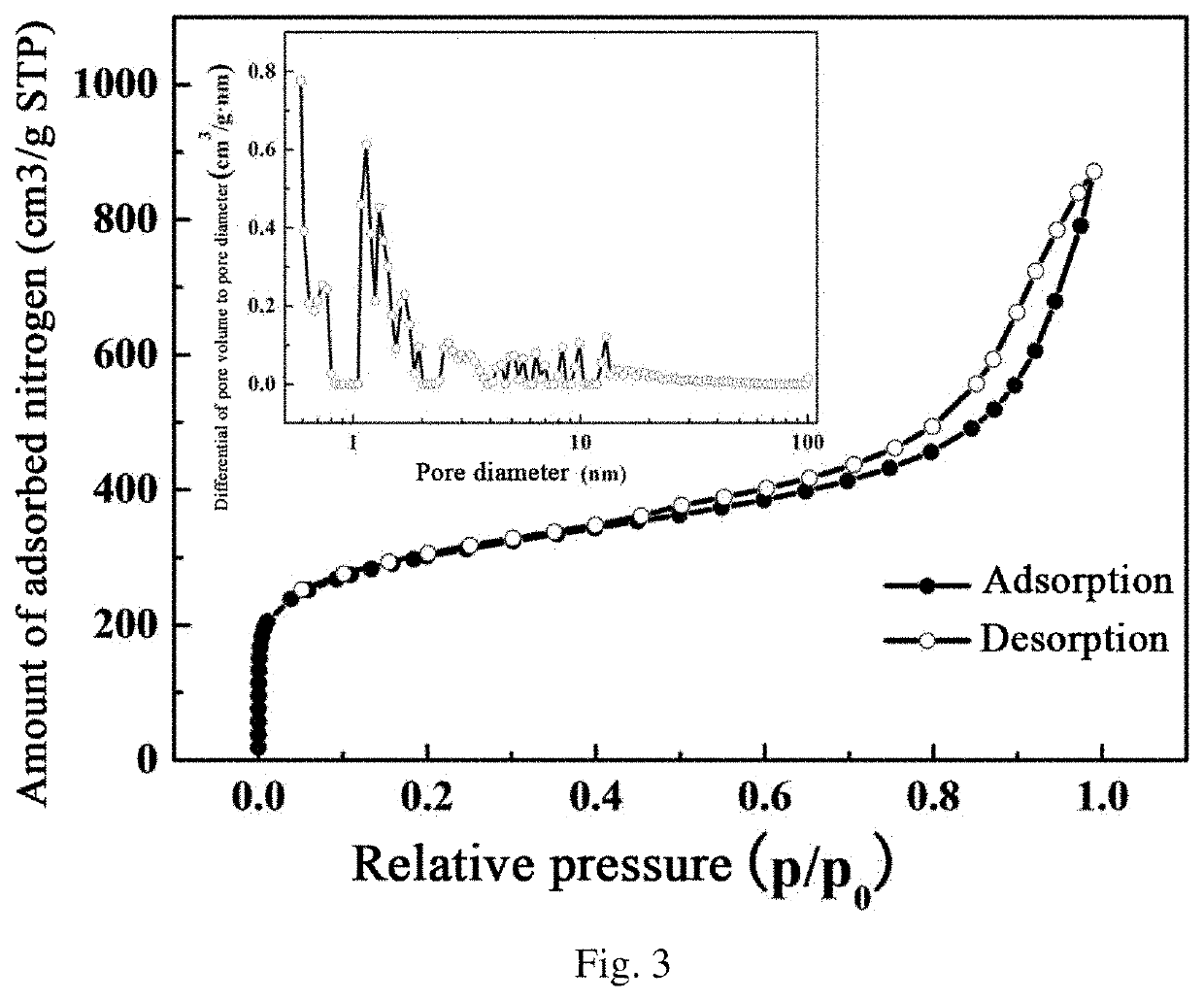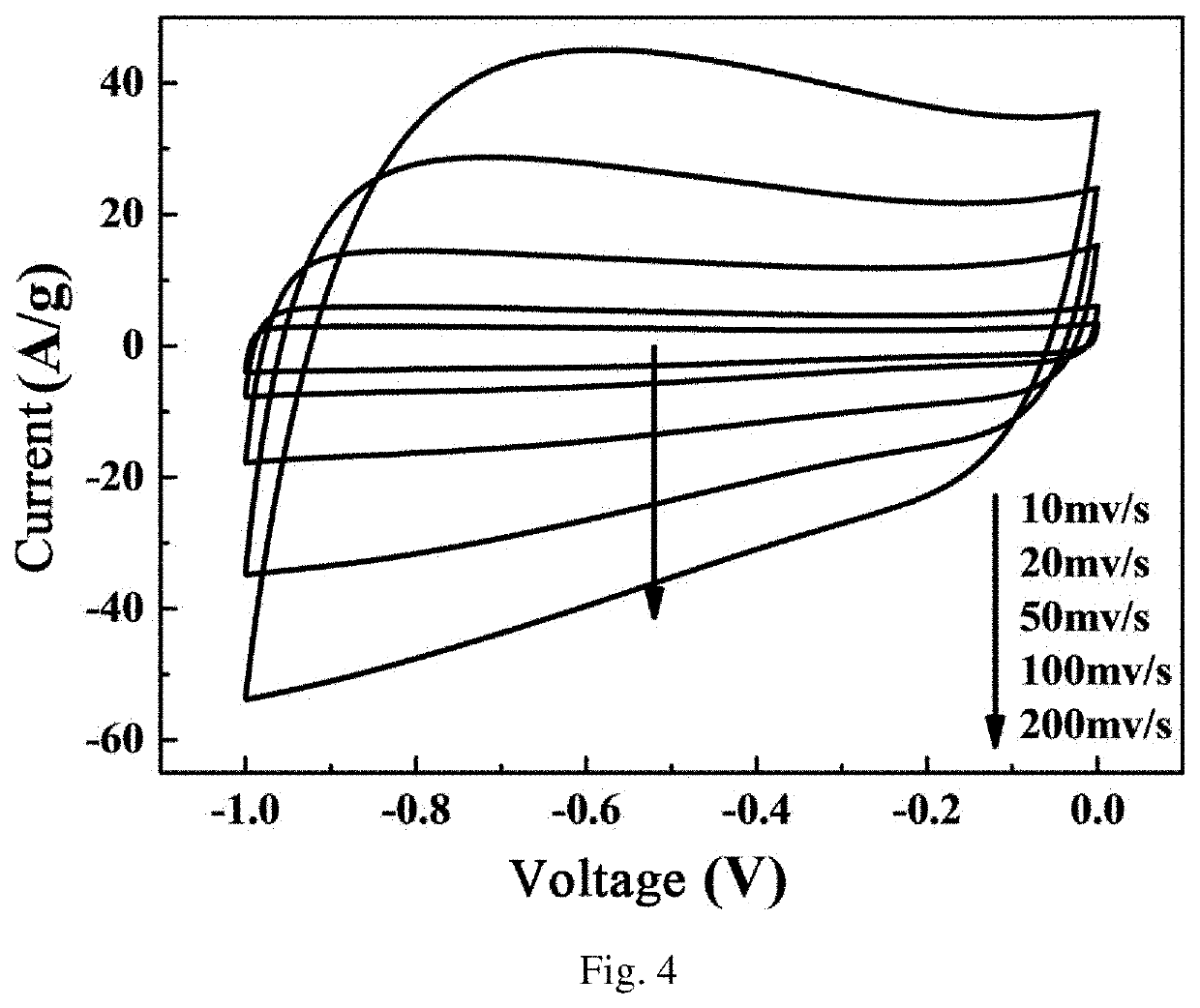Lignin Porous Carbon Nanosheet, Preparation Method Therefor, and Application Thereof in Supercapacitor Electrode Materials
- Summary
- Abstract
- Description
- Claims
- Application Information
AI Technical Summary
Benefits of technology
Problems solved by technology
Method used
Image
Examples
example 1
[0063]Weighing 5 parts by mass of sodium lignosulfonate and 5 parts by mass of zinc oxalate solid powder to dissolve in 500 parts by volume of water, and stirring uniformly to obtain a stable dispersive liquid A; taking 50 parts by volume of the dispersive liquid A, adding 50 parts by volume of ethanol thereto while stirring, and separating the precipitate after standing to obtain a lignin / zinc oxalate composite; then taking 50 parts by volume of the dispersive liquid A, adding the prepared lignin / zinc oxalate composite thereto and stirring for 20 min, adding 50 parts by volume of ethanol, and separating the lignin / zinc oxalate composite after standing; repeating the above steps 6 times, and separating the precipitate to obtain the layer-by-layer self-assembled lignin / zinc oxalate composite.
[0064]Placing the layer-by-layer self-assembled lignin / zinc oxalate composite in an inert atmosphere, and carbonizing at 750° C. for 3 h to obtain the lignin carbon / zinc oxide composite; immersin...
example 2
[0065]Weighing 10 parts by mass of magnesium lignosulfonate and 5 parts by mass of magnesium oxalate solid powder to dissolve in 500 parts by volume of water, and stirring uniformly to obtain a stable dispersive liquid A; taking 50 parts by volume of the dispersive liquid A, adding 50 parts by volume of ethanol thereto while stirring, and separating the precipitate after standing to obtain a lignin / magnesium oxalate composite; then taking 50 parts by volume of the dispersive liquid A, adding the prepared lignin / magnesium oxalate composite thereto and stirring for 20 min, adding 50 parts by volume of ethanol, and separating the lignin / magnesium oxalate composite after standing; repeating the above steps 8 times, and separating the precipitate to obtain the layer-by-layer self-assembled lignin / magnesium oxalate composite.
[0066]Placing the layer-by-layer self-assembled lignin / magnesium oxalate composite in an inert atmosphere, and carbonizing at 550° C. for 4 h to obtain the lignin car...
example 3
[0067]Weighing 5 parts by mass of calcium lignosulfonate and 7.5 parts by mass of calcium oxalate solid powder to dissolve in 500 parts by volume of water, and stirring uniformly to obtain a stable dispersive liquid A; taking 50 parts by volume of the dispersive liquid A, adding 50 parts by volume of ethanol thereto while stirring, and separating the precipitate after standing to obtain a lignin / calcium oxalate composite; then taking 50 parts by volume of the dispersive liquid A, adding the prepared lignin / calcium oxalate composite thereto and stirring for 20 min, adding 50 parts by volume of ethanol, and separating the lignin / calcium oxalate composite after standing; repeating the above steps 6 times, and separating the precipitate to obtain the layer-by-layer self-assembled lignin / calcium oxalate composite.
[0068]Placing the layer-by-layer self-assembled lignin / calcium oxalate composite in an inert atmosphere, and carbonizing at 650° C. for 3 h to obtain the lignin carbon / calcium o...
PUM
 Login to View More
Login to View More Abstract
Description
Claims
Application Information
 Login to View More
Login to View More - R&D
- Intellectual Property
- Life Sciences
- Materials
- Tech Scout
- Unparalleled Data Quality
- Higher Quality Content
- 60% Fewer Hallucinations
Browse by: Latest US Patents, China's latest patents, Technical Efficacy Thesaurus, Application Domain, Technology Topic, Popular Technical Reports.
© 2025 PatSnap. All rights reserved.Legal|Privacy policy|Modern Slavery Act Transparency Statement|Sitemap|About US| Contact US: help@patsnap.com



